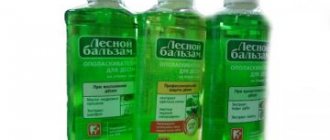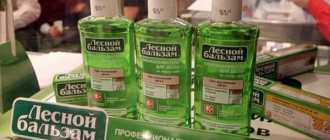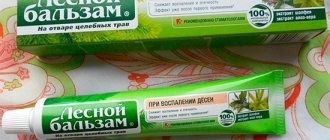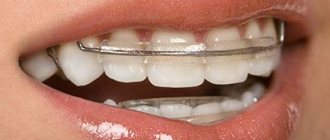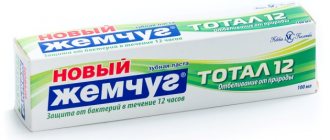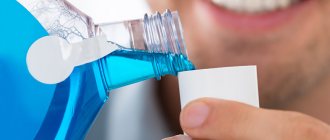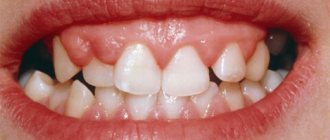Author of the article:
Soldatova Lyudmila Nikolaevna
Candidate of Medical Sciences, Professor of the Department of Clinical Dentistry of the St. Petersburg Medical and Social Institute, Chief Physician of the Alfa-Dent Dental Clinic, St. Petersburg
1. Asepta adhesive gum balm is used during periods of gum inflammation, bleeding, during exacerbation of a chronic process, including with abundant serous-purulent or purulent discharge from periodontal pockets, with severe catarrhal gingivitis. The balm should be applied to the area of inflammation 2 times a day for 7-10 days, but no more than 2 weeks, to avoid the occurrence of dysbacteriosis in the oral cavity.
To increase the effectiveness of use, it is recommended to apply the balm after eating and brushing your teeth, after which you should refrain from eating and drinking for 1.5 hours.
2. Asepta mouth rinse can be used at the time of exacerbation, combined with a course of using an adhesive balm, but using them at different times during the day. For the best effect, apply the balm after rinsing.
In case of minor inflammation, Asepta rinse can be used as an independent remedy. It is recommended to use the rinse two to three times a day for five to seven days, but not longer than three weeks. Long-term use can lead to dysbiosis in the oral cavity.
3. Gel for gums with propolis “Asepta” should be used already at the stage of recovery (during the period of remission) as maintenance therapy after using the balm and rinse “Asepta” in the acute period.
Additionally, propolis gel can be used to accelerate tissue regeneration during the healing period after periodontal surgery.
Gum gel with propolis should be applied 2-3 times a day for 7-14 days.
Attention: due to the possibility of allergic reactions to propolis in some people, you should not use propolis gel if you have allergic reactions to bee products.
4. Therapeutic and prophylactic toothpaste “Asepta” or “Asepta Sensitive” should be used throughout the entire course of treatment for inflammatory gum diseases. It is recommended to use toothpastes at least twice a day.
Asepta toothpastes can also be used to prevent inflammatory periodontal diseases to maintain good condition of gums and teeth.
5. Asepta Fresh mouth rinse is perfect for daily maintenance of healthy gums and teeth, including reducing the likelihood of repeated exacerbations of chronic forms of inflammatory periodontal diseases.
6. “Vitamin and mineral complex for teeth “ASEPTA” increases the effectiveness of anti-inflammatory therapy for diseases of the oral cavity. It is also used for preventive purposes to strengthen and maintain the health of gums and teeth.
Content:
- Active substance
- Indications for use
- How to use it correctly
- Benefits of the medicine
- Contraindications
In the treatment of many dental diseases, doctors use local anti-inflammatory drugs.
They have an impact directly on the source of inflammation, thanks to which the doctor quickly gets positive results. The drug Asepta, made from the waste product of bees, is in particular demand in dental practice. It is produced by a Russian pharmaceutical company. In pharmacies, the product can be purchased in the form of a gel located inside a plastic tube. The kit includes a small spatula applicator for convenient use of the medicine.
Active substance
The official instructions indicate that the gum base contains only one active ingredient - propolis. As is known, it has antimicrobial, anti-inflammatory, analgesic and antipruritic properties, and exhibits pronounced activity against gram-positive bacteria.
The composition with propolis accelerates regeneration, promotes rapid epithelization of wound surfaces in the mouth, and supports the normal course of metabolic processes. Studies have shown that it reduces gum inflammation by 31%.
The medicinal effect of the beekeeping product is explained by the presence in it of a number of biologically active organic compounds. They have a direct effect on oral tissues and pathogenic bacteria, thereby ensuring positive results in the treatment of a wide variety of dental ailments.
Main properties of propolis:
- Significantly reduces or completely eliminates pain and discomfort in the gums. But you need to understand that pain relief is not an easy task. With severe pain symptoms, it will not be possible to do without analgesics. The analgesic effect of Asept gel manifests itself gradually, so it is important not to forget to re-treat the gums in a timely manner.
- Fights inflammation, provides excellent prevention of purulent and necrotic processes. Reduces the severity of swelling, removes redness, normalizes the temperature in the damaged area and helps restore full blood circulation.
- Destroys pathogenic microflora. Doctors refer to the “creation of bees” as a natural antibiotic. It does not disturb the natural microflora of the oral cavity and does not cause undesirable consequences.
- Accelerates wound healing. With regular use of the medicine, wounds and ulcers heal much faster. Inflammation subsides already on the second or third day of treatment.
Taken together, these properties make propolis an important assistant for dentists. If you have been prescribed this drug, listen to your doctor’s opinion - Asepta copes with a wide variety of lesions.
How often should you use the balm?
To prevent exacerbations of chronic gingivitis and periodontitis, it is recommended to use the product twice a day for 7-10 days. To prevent exacerbations of classic gingivitis and periodontitis, the balm is used twice a day for 7-10 days.
Prevention of inflammation with the help of balm can be carried out 2-3 times a year.
This adhesive gum balm has a minimum of contraindications - pregnancy and breastfeeding, individual intolerance to chlorhexidine, metronidazole and other components.
ASEPTA adhesive gum balm is a real salvation for stomatitis, gingivitis, periodontitis and other inflammatory diseases. Clinically proven: the product reduces gum inflammation by 50% and reduces gum bleeding by 51% when used for 7 days.
Indications for use
Dentists recommend using the medication for:
- Gingivitis is inflammation of the gums. It manifests itself as swelling, pain, redness, and bad breath. The product blocks the further spread of inflammation, heals tissues and accelerates their healing. It can be used as monotherapy only at the initial stage of gingivitis. If the disease is advanced, the gel should act as a concomitant therapy.
- Periodontitis. A dangerous disease that causes disruption of the periodontal junction. Promotes loosening and premature tooth loss. The remedy for periodontitis is prescribed at the final stage of treatment - when the formed periodontal pockets are cleaned and treated. "Asepta" allows you to speed up recovery and shorten the patient's rehabilitation period.
- Trophic ulcers in the mouth. With this diagnosis, ulcerative lesions that are painful to the touch are formed on the mucous membranes. In the absence of timely treatment, the area of damaged tissue increases, and regional lymph nodes become inflamed. The medication helps at any stage of the ulcerative process. They must be treated according to the scheme specified by the doctor.
- Stomatitis (except for aphthous form). A pathology in which the mucous membranes of the mouth become inflamed. First, small inflamed ulcers appear, which gradually increase in size. It is necessary to start treating them as early as possible, then the abnormal process will not have time to spread widely. “Asepta” for stomatitis should be combined with antiviral drugs.
- Mechanical damage to the gums. Inflammation is often a consequence of dental procedures, rubbing of dentures, eating too hard foods, and the habit of gnawing on foreign objects. To prevent secondary infection and other complications, you should start using the gel composition immediately after the integrity of the mucous membrane is damaged. Then healing will take place much faster.
Since the drug is made on the basis of natural compounds and has a high safety profile, it can be used to prevent gingivitis and periodontitis if there is a tendency to these diseases.
How to use it correctly
The instructions say that the composition must be applied to the gums and affected areas of the oral mucosa in a thin layer. You can do this with your finger (be sure to wash your hands first!) or using a special applicator.
You should not eat or drink anything for half an hour after treatment. Otherwise, the medicine will not have time to work. Frequency of use: two or three times a day. The duration of the course should be from seven to fourteen days. For prevention purposes, it is recommended to use the drug two to three times a year.
How to use adhesive gum balm?
For gum balm to be effective, you must use it correctly:
- Before using the balm, you should thoroughly brush your teeth and rinse your mouth.
- Then it is important to dry the gums properly with a cotton or gauze swab. When applied to a damp surface, the duration of action of the balm is reduced.
- Apply the balm to the gums using a special spatula, which is included in each package.
- Moisten the applied balm with water.
It is not recommended to eat food within 60-90 minutes after applying the balm to the gums.
Benefits of the medicine
In addition to affordable cost and high efficiency, the gel has other advantages:
- The soft gel texture allows it to be applied evenly and easily distributed even in hard-to-reach areas of the mouth. The product is suitable for spot treatment of fabrics.
- The neutral taste does not cause discomfort during therapeutic procedures.
- The presence of an applicator in the kit allows for processing in compliance with established aseptic requirements.
- The product has passed the necessary clinical tests, which confirmed its safety and effectiveness.
- Can be used for various dental diagnoses. It combines well with other medications.
Contraindications
The components present in the composition do not have a systemic effect on the body. In rare cases, patients develop allergic reactions during the treatment course. For this reason, Asepta is not prescribed for aphthous stomatitis, since if an allergy develops, the course of the disease worsens sharply.
An absolute contraindication to the use of the drug is individual intolerance to bee products. After all, the basis of the medicine is propolis.
As for therapy during pregnancy and lactation, it is also not recommended. But not because the medicine is dangerous for this category of patients, but because the necessary clinical studies on this issue have not yet been carried out.
It is important to understand: Although Asepta prevents the proliferation of pathogenic microflora, it does not replace standard hygiene procedures. Therefore, it is important to regularly use a toothbrush and toothpaste during treatment.
ASEPTA gel for gums: reviews
Asepta gel does not have a pronounced antimicrobial and anti-inflammatory effect, and if you expect a noticeable effect from it, you will certainly be dissatisfied with its use. In our opinion, it is optimal to use the gel only as courses for the prevention of gingivitis/periodontitis. Such courses of maintenance therapy can be carried out 2-3 times a year - between courses of professional anti-inflammatory therapy and removal of dental plaque.
Another optimal indication for Asepta gel is periodontal disease, i.e. metabolic-dystrophic gum disease that occurs in elderly patients due to deterioration of blood microcirculation in the bone tissue of the jaws. But periodontal disease should not be confused with gingivitis and periodontitis. Gingivitis and periodontitis are inflammatory diseases of the gums, and with them there is always swelling and bleeding of the gums.
And with periodontal disease, inflammation in the gums is always absent, and symptoms manifest themselves only as a gradual progressive decrease in the level of bone tissue around the teeth (which leads to exposure of the roots of the teeth). Moreover, the use of Asept gel for periodontal disease will not be accompanied by visible improvements, and its use will only slightly slow down the process of bone tissue degeneration.
Important: reviews on ASEPTA gum gel for use (for erosions and ulcers due to stomatitis) boil down to the fact that the drug is ineffective for these purposes. In addition, in these cases it can lead to irritation and even allergic reactions. It is best to use other forms of drugs to treat painful erosions, for example, Cholisal gel, which not only relieves pain, but also reduces inflammation and speeds up the healing of ulcerations.
Contraindications and side effects -
When applied to the mucous membrane, the components of the drug do not have any systemic effect.
Occasionally, only allergic reactions may occur. It is precisely because of the latter that Asept gel is not recommended for use in aphthous stomatitis, because Often it is an allergic reaction that causes aphthae (ulcers) to appear on the mucous membrane. And applying propolis gel to ulcers can only worsen their healing. An absolute contraindication is an allergy to bee products, or an allergy to one of the components of the gel. The use of the gel during pregnancy and lactation is not recommended, because the manufacturer notes that clinical studies on this issue have not been conducted.

